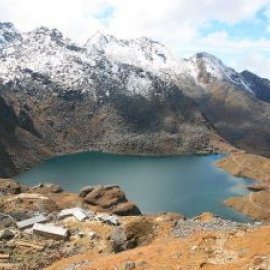A Danger of Dams
-
English
-
ListenPause
I’m Peter Neill, Director of the World Ocean Observatory. One of the greatest expressions of engineering hubris has been the construction of ever-larger dams to transform the energy of free-flowing rivers into massive reservoirs of water for controlled release and hydro-generated energy. In the United States, and in Egypt, India and China, enormous dams in remote places have become symbols of national pride and emerging economy designed to bring energy to distant cities and growing urban populations and industrial enterprise. The construction of these dams required equally enormous investment of capital and labor, financed, supervised, and subsequently managed primarily by central governments or their specially designated authorities. In 1957, the historian Karl Wittvogel published “Oriental Despotism,” a survey of the reliance of ancient society on the control of water, examples again in the Middle East, India, and China, of similar engineering projects where dams, reservoirs, canals, and distribution systems facilitated the growth and sustenance of sustainable societies on a scale far greater and more successful as a result of abundant water and its provenance. Such projects could only be managed by a power great enough to command the financial resources and the slave labor required to build such cities. To construct modern dams requires equally authoritative regimes – either by legislative decree or dictatorial fiat. The Aswan Dam in Egypt, the engineered river linkage projects in India, and the Three Gorges Dam and north-south canal water transport systems in China are all examples of a similar pattern – central government, unlimited finance, cheap labor, and no fear of opposition or consequence of the environmental damage, social dislocation, and cultural destruction that follows. Nepal was recently devastated by a major earthquake that left many thousands dead, many more thousands unrecovered, and the country bereft of resources to respond or to restore what was their simple modicum of life. Isabel Hilton in an excellent report for the New Yorker Magazine reveals a chilling sidebar to the larger earthquake story, the rescue by helicopter of 280 Chinese workers from the construction site of the hydropower dam on the Tishuli River, some 86 miles from Kathmandu, and 40 miles from the epicenter. The 350 Nepali workers were left to fend for themselves. According to the Three Gorges Corporation, the construction company owned by the Chinese government, the dam was “severely damaged.” “The Rasuwaghadi dam,” reports Ms. Hilton, “is one of three contracts won in the area by the Three Gorges Corporation, and one of thirteen planned along this stretch of the river. The company, which has been repeatedly implicated in corruption in China, has also won the contract to build the controversial seven-hundred-and-fifty megawatt West Seti dam, which, at US$1.6 billion, will be Nepal’s biggest-ever foreign investment.” What does it mean that Rasuwaghadi was “severely damaged?” What would be the catastrophic downstream destruction if an aftershock or larger quake caused the dam to collapse? Here is the most disturbing paragraph in Ms. Hilton’s report: “Geologists argue that the risks of building dams in earthquake zones go well beyond an earthquake-induced collapse…But the most fiercely debated risk, since the 7.9-magnitude Sichuan earthquake in 2008, which killed seventy thousand people and left nearly twenty thousand missing, is that of ‘reservoir-induced seismicity’ – the theory that the weight of water behind a dam, coupled with the seeping of water into the fissures in rocks below, can produce shearing stress strong enough to worsen, or trigger an earthquake.” What I think this suggests is that the first tremor can create further tremor within the water reserve and the underlying geology so as to amplify the quake into reverberation increasing the probability of collapse. Yes, Nepal needs this energy for its own security, development, and financial stability. But what is really being wrought here? These mega-projects -- and there are many more of them -- are fed mostly by glacial melt, a phenomenon put in question by the already evident effect of global warming on the glacier as source. Thus, these dams may be over-engineered for a future inadequate supply or under-engineered for the risk of an earthquake zone. Water is power, physical and political, with inherent force not always acquiescent to our ambitions and prideful dreams. We attempt to master it at our peril. We will discuss these issues, and more, in future editions of World Ocean Radio.
The Rasuwaghadi Dam project in Nepal, severely damaged by the recent earthquake, is mired in controversy. One of many mega-projects along the Tishuli River, it is simultaneously over-engineered due to future inadequate supply of water from decreased glacial melt, and under-engineered due to risk factors such as earthquakes. In this episode of World Ocean Radio host Peter Neill will cite from a recent report from New Yorker Magazine author Isabel Hunter who revealed sobering facts about the Rasuwaghadi Dam and its ilk: projects fueled by central governments, unlimited finance, cheap labor, environmental disregard, social dislocation, and cultural destruction.
About World Ocean Radio:
Peter Neill, Director of the World Ocean Observatory and host of World Ocean Radio, provides coverage of a broad spectrum of ocean issues from science and education to advocacy and exemplary projects. World Ocean Radio, a project of the World Ocean Observatory, is a weekly series of five-minute audio essays available for syndicated use at no cost by college and community radio stations worldwide. A selection of episodes is now available in Portuguese, Spanish, French, and Swahili. In 2015 we will add Mandarin to our roster of global languages, enabling us to reach 75% of the world's population. For more information, visit WorldOceanObservatory.org/world-ocean-radio-global.
Image: Sacred water of Gosainkunda Lake at the headwaters of the Trishuli River, soon to be changed by mega-projects such as the Rasuwaghadi dam.
Image Credit: Yosarian via Wikimedia Commons (CC BY).
- Login to post comments



